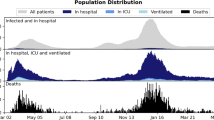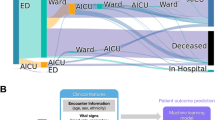Abstract
The coronavirus disease 2019 (COVID-19) is an infectious and high transmissible disease that may cause severe illness. Some severe cases might require intensive care unit (ICU) admission because, in some cases, patients had comorbidities and several previous symptoms that can worst their condition. Therefore, it is of paramount importance to find strategies for helping manage the occupancy of ICU units. In this paper, we present a predictive model about ICU admission. We trained different machine learning (ML) models using a dataset containing previous symptoms and risk factors, such as demographics. The algorithms used were Random Forest (RF), Logistic Regression (LR), and Extreme Learning Machine (ELM), and the metrics used to evaluate them were accuracy, balanced accuracy, sensitivity, and specificity. We used RandomOverSampling (ROS), NearMiss (NM), and SMOTE algorithms to balance the dataset at different proportions. The best RF obtained model got a specificity of around 97%. The best LR model gives specificity about 93% and, the best ELM obtained a specificity of 94%. These results demonstrate the excellent performance of these algorithms in these kinds of datasets. Moreover, our findings show that ROS and SMOTE performed better than NM.
Access this chapter
Tax calculation will be finalised at checkout
Purchases are for personal use only
Similar content being viewed by others
References
Idescat. Anuari estadístic de Catalunya. Densitat de població. Comarques i Aran, àmbits i províncies (2014). https://www.idescat.cat/pub/?id=aec &n=249 &t=2014
Akusok, A., Espinosa Leal, L., Björk, K.M., Lendasse, A.: Scikit-elm: an extreme learning machine toolbox for dynamic and scalable learning. In: International Conference on Extreme Learning Machine, pp. 69–78. Springer (2019)
Ao, Y., Li, H., Zhu, L., Ali, S., Yang, Z.: The linear random forest algorithm and its advantages in machine learning assisted logging regression modeling. J. Pet. Sci. Eng. 174, 776–789 (Mar 2019). https://doi.org/10.1016/J.PETROL.2018.11.067
Barua, S., Islam, M.M., Yao, X., Murase, K.: MWMOTE - Majority weighted minority oversampling technique for imbalanced data set learning. IEEE Trans. Knowl. Data Eng. 26(2), 405–425 (Feb 2014). https://doi.org/10.1109/TKDE.2012.232
Buetti, N., Ruckly, S., de Montmollin, E., Reignier, J., Terzi, N., Cohen, Y., Siami, S., Dupuis, C., Timsit, J.F.: COVID-19 increased the risk of ICU-acquired bloodstream infections: a case-cohort study from the multicentric OUTCOMEREA network. Intensive Care Med. 47(2), 180–187 (Jan 2021). https://doi.org/10.1007/S00134-021-06346-W, https://link.springer.com/article/10.1007/s00134-021-06346-w
Chawla, N.V., Bowyer, K.W., Hall, L.O., Kegelmeyer, W.P.: SMOTE: Synthetic minority over-sampling technique. J. Artif. Intell. Res. 16, 321–357 (Jun 2002). https://doi.org/10.1613/jair.953, https://www.jair.org/index.php/jair/article/view/10302
Cheng, F.Y., Joshi, H., Tandon, P., Freeman, R., Reich, D.L., Mazumdar, M., Kohli-Seth, R., Levin, M.A., Timsina, P., Kia, A.: Using machine learning to predict ICU transfer in hospitalized COVID-19 patients. J. Clin. Med. 9(6), 1668 (Jun 2020). https://doi.org/10.3390/JCM9061668, https://www.mdpi.com/2077-0383/9/6/1668/htmhttps://www.mdpi.com/2077-0383/9/6/1668
Cutler, A., Cutler, D.R., Stevens, J.R.: Random forests. Springer, Boston, MA, Boston, MA (2012). https://link.springer.com/chapter/10.1007/978-1-4419-9326-7_5
Esai Selvan, M.: Risk factors for death from COVID-19. Nat. Rev. Immun. 20(7), 407–407 (May 2020). https://doi.org/10.1038/s41577-020-0351-0, https://www.nature.com/articles/s41577-020-0351-0
Espinosa-Leal, L., Akusok, A., Lendasse, A., Björk, K.M.: Website classification from webpage renders. In: International Conference on Extreme Learning Machine, pp. 41–50. Springer (2019)
Florensa, D., Godoy, P., Mateo, J., Solsona, F., Pedrol, T., Mesas, M., Pinol, R.: The use of multiple correspondence analysis to explore associations between categories of qualitative variables and cancer incidence. IEEE J. Biomed. Health Inf. 25(9), 3659–3667 (Sep 2021). https://doi.org/10.1109/JBHI.2021.3073605
Geetha, R., Sivasubramanian, S., Kaliappan, M., Vimal, S., Annamalai, S.: Cervical cancer identification with synthetic minority oversampling technique and PCA analysis using random forest classifier. J. Med. Syst. 43(9), 1–19 (2019). https://doi.org/10.1007/s10916-019-1402-6
Gianfrancesco, M.A., Tamang, S., Yazdany, J., Schmajuk, G.: Potential biases in machine learning algorithms using electronic health record data. JAMA Intern. Med. 178(11), 1544–1547 (Nov 2018). https://doi.org/10.1001/JAMAINTERNMED.2018.3763, https://jamanetwork.com/journals/jamainternalmedicine/fullarticle/2697394
H, B., JM, H., M, T., VM, K., A, M.: Predicting breast cancer risk using interacting genetic and demographic factors and machine learning. Sci. Rep. 10(1) (Dec 2020). https://doi.org/10.1038/S41598-020-66907-9, https://pubmed.ncbi.nlm.nih.gov/32632202/
Han, H., Wang, W.Y., Mao, B.H.: Borderline-SMOTE: a new over-sampling method in imbalanced data sets learning. In: Lecture Notes in Computer Science (including subseries Lecture Notes in Artificial Intelligence and Lecture Notes in Bioinformatics) LNCS. vol. 3644, pp. 878–887. Springer (2005). https://link.springer.com/chapter/10.1007/11538059_91
He, F., Quan, Y., Lei, M., Liu, R., Qin, S., Zeng, J., Zhao, Z., Yu, N., Yang, L., Cao, J.: Clinical features and risk factors for ICU admission in COVID-19 patients with cardiovascular diseases. Aging Dis. 11(4), 763 (2020). https://doi.org/10.14336/AD.2020.0622, /pmc/articles/PMC7390529/ /pmc/articles/PMC7390529/?report=abstract https://www.ncbi.nlm.nih.gov/pmc/articles/PMC7390529/
Huang, G.B., Zhu, Q.Y., Siew, C.K.: Extreme learning machine: theory and applications. Neurocomputing 70(1–3), 489–501 (Dec 2006). https://doi.org/10.1016/J.NEUCOM.2005.12.126
KaurHarsurinder, Singh, P., Kaur, M.: A Systematic review on imbalanced data challenges in machine learning. ACM Comput. Surv. (CSUR) 52(4) (Aug 2019). https://doi.org/10.1145/3343440, https://dl.acm.org/doi/abs/10.1145/3343440
Lemon, S.C., Roy, J., Clark, M.A., Friedmann, P.D., Rakowski, W.: Classification and regression tree analysis in public health: methodological review and comparison with logistic regression. Ann. Behav. Med. 26(3), 172–181 (2003). https://link.springer.com/article/10.1207/S15324796ABM2603_02
Lighter, J., Phillips, M., Hochman, S., Sterling, S., Johnson, D., Francois, F., Stachel, A.: Obesity in patients younger than 60 years is a risk factor for COVID-19 hospital admission. Clin. Infect. Dis. 71(15), 896–897 (Jul 2020). https://doi.org/10.1093/CID/CIAA415, https://academic.oup.com/cid/article/71/15/896/5818333
Lu, W., Hou, H., Chu, J.: Feature fusion for imbalanced ECG data analysis. Biomed. Sig. Process. Control 41, 152–160 (Mar 2018). https://doi.org/10.1016/J.BSPC.2017.11.010
Pedregosa, F., Varoquaux, G., Gramfort, A., Michel, V., Thirion, B., Grisel, O., Blondel, M., Prettenhofer, P., Weiss, R., Dubourg, V., Vanderplas, J., Passos, A., Cournapeau, D., Brucher, M., Perrot, M., Duchesnay, E.: Scikit-learn: machine learning in python. J. Mach. Learn. Res. 12, 2825–2830 (2011)
Rahman, M.M., Davis, D.N.: Addressing the class imbalance problem in medical datasets. Int. J. Mach. Learn. Comput. 224–228 (2013). https://doi.org/10.7763/IJMLC.2013.V3.307
RD, N., T, A., L, L., I, D.: Diagnostic accuracy of different machine learning algorithms for breast cancer risk calculation: a meta-analysis. Asian Pac. J. Cancer Prev. : APJCP 19(7), 1747–1752 (Jul 2018). https://doi.org/10.22034/APJCP.2018.19.7.1747, https://pubmed.ncbi.nlm.nih.gov/30049182/
Roncon, L., Zuin, M., Rigatelli, G., Zuliani, G.: Diabetic patients with COVID-19 infection are at higher risk of ICU admission and poor short-term outcome. J. Clin. Virol. 127, 104354 (Jun 2020). https://doi.org/10.1016/J.JCV.2020.104354
Subudhi, S., Verma, A., Patel, A.B., Hardin, C.C., Khandekar, M.J., Lee, H., McEvoy, D., Stylianopoulos, T., Munn, L.L., Dutta, S., Jain, R.K.: Comparing machine learning algorithms for predicting ICU admission and mortality in COVID-19. npj Digit. Med. 4(1), 1–7 (May 2021). https://doi.org/10.1038/s41746-021-00456-x, https://www.nature.com/articles/s41746-021-00456-x
Sun, Z., Song, Q., Zhu, X., Sun, H., Xu, B., Zhou, Y.: A novel ensemble method for classifying imbalanced data. Pattern Recogn. 48(5), 1623–1637 (May 2015). https://doi.org/10.1016/J.PATCOG.2014.11.014
Tartari, F., Guglielmo, A., Fuligni, F., Pileri, A.: Changes in emergency service access after spread of COVID19 across Italy. J. Eur. Acad. Dermatol. Venereology 34(8), e350–e351 (Aug 2020). https://doi.org/10.1111/JDV.16553,/pmc/articles/PMC7267617/?report=abstract https://www.ncbi.nlm.nih.gov/pmc/articles/PMC7267617/
Tharwat, A.: Classification assessment methods. Appl. Comput. Inf. 17(1), 168–192 (2020)
Ting, W.C., Lu, Y.C.A., Ho, W.C., Cheewakriangkrai, C., Chang, H.R., Lin, C.L.: Machine learning in prediction of second primary cancer and recurrence in colorectal cancer. Int. J. Med. Sci. 17(3), 280–291 (2020). https://doi.org/10.7150/IJMS.37134
Wang, D., Hu, B., Hu, C., Zhu, F., Liu, X., Zhang, J., et. al: Clinical characteristics of 138 hospitalized patients with 2019 novel coronavirus-infected pneumonia in Wuhan, China. JAMA 323(11), 1061–1069 (Mar 2020). https://doi.org/10.1001/JAMA.2020.1585, https://jamanetwork.com/journals/jama/fullarticle/2761044
Yan, S., Qian, W., Guan, Y., Zheng, B.: Improving lung cancer prognosis assessment by incorporating synthetic minority oversampling technique and score fusion method. Med. Phys. 43(6Part1), 2694–2703 (May 2016). https://doi.org/10.1118/1.4948499, http://doi.wiley.com/10.1118/1.4948499
Zhang, Y., Zhu, S., Yuan, Z., Li, Q., Ding, R., Bao, X., Zhen, T., Fu, Z., Fu, H., Xing, K., Yuan, H., Chen, T.: Risk factors and socio-economic burden in pancreatic ductal adenocarcinoma operation: a machine learning based analysis. BMC Cancer 20(1), 1–12 (Nov 2020). https://doi.org/10.1186/S12885-020-07626-2, https://bmccancer.biomedcentral.com/articles/10.1186/s12885-020-07626-2
Zhao, Z., Chen, A., Hou, W., Graham, J.M., Li, H., Richman, P.S., Thode, H.C., Singer, A.J., Duong, T.Q.: Prediction model and risk scores of ICU admission and mortality in COVID-19. PLOS ONE 15(7), e0236618 (Jul 2020). https://doi.org/10.1371/JOURNAL.PONE.0236618, https://journals.plos.org/plosone/article?id=10.1371/journal.pone.0236618
Acknowledgments
The authors wish to acknowledge CSC – IT Center for Science, Finland, for computational resources.
Author information
Authors and Affiliations
Corresponding author
Editor information
Editors and Affiliations
Rights and permissions
Copyright information
© 2023 The Author(s), under exclusive license to Springer Nature Switzerland AG
About this paper
Cite this paper
Florensa, D., Mateo, J., Solsona, F., Godoy, P., Espinosa-Leal, L. (2023). On the Intensive Care Unit Admission During the COVID-19 Pandemic in the Region of Lleida, Spain: A Machine Learning Study. In: Björk, KM. (eds) Proceedings of ELM 2021. ELM 2021. Proceedings in Adaptation, Learning and Optimization, vol 16. Springer, Cham. https://doi.org/10.1007/978-3-031-21678-7_9
Download citation
DOI: https://doi.org/10.1007/978-3-031-21678-7_9
Published:
Publisher Name: Springer, Cham
Print ISBN: 978-3-031-21677-0
Online ISBN: 978-3-031-21678-7
eBook Packages: Intelligent Technologies and RoboticsIntelligent Technologies and Robotics (R0)




